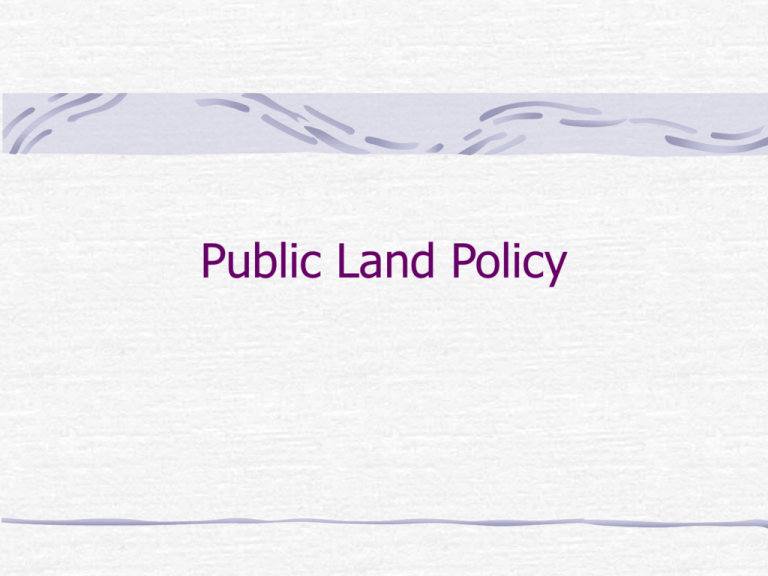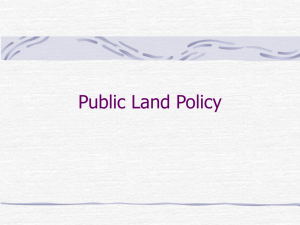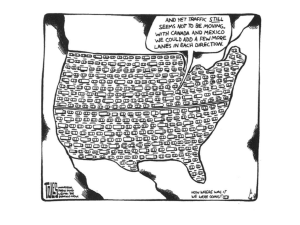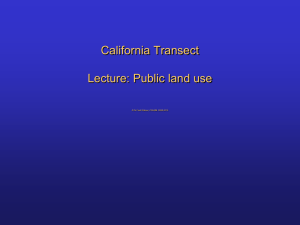Public Land Policy
advertisement

Public Land Policy Resource Exploitation 1865-1890 Goal--encouraged the settlement of the land Means-- Privatization Homestead Act of 1862 1872 mining law Efficiency Movement 18901920 Bureau of Forestry- G. Pinchot Taylor Grazing Act of 1934 Gospel of Efficiency “Conservation is the greatest good for the greatest # of people for the longest time” Federal Reclamation Service, 1902 Preservation Movement -Creation of National Park System, Antiquities Act, Fish and Wildlife Service "The man should have youth and strength who seeks adventure in the wide, waste spaces of the earth, in the marshes, and among the vast mountain masses, in the northern forests, amid the steaming jungles of the tropics, or on the desert of sand or of snow. He must long greatly for the lonely winds that blow across the wilderness, and for sunrise and sunset over the rim of the empty world." Theodore Roosevelt Big Questions What is land good for? Who makes the decision? How to balance competing values? Role of public sector? Role of private sector Role of science/values Public Lands Administered by different agencies National Park Service (NPS) Fish and Wildlife Service (FWS) Bureau of Land Management (BLM) in Interior Forest Service (FS) Agriculture Different mission 29% of US land 92% of lands are in 12 western states National Park Service Most restrictive limits on usage 77 million acres Diverse categories of units National Parks National Preserves National Monuments Misc National Parks National Preserves Big Cypress Aniakchak Caldera Tallgrass Prairie Bering Land Bridge National Monuments Canyon de Chelly Pt. Reyes National Seashore Saratoga National Battlefield Recreation Conflict National Wildlife Refuge System Managed by Fish and Wildlife Service Responsibilities include 93 million acres in 512 national wildlife refuges, 198 waterfowl production areas, 50 wildlife coordination areas 114 other sites Mission- conserve and enhance fish and wildlife and their habitats Bureau of Land Management Federal Land Policy and Management Act of 1976 (FLPMA) "multiple use" "management of the public lands and their various resource values so that they are utilized in the combination that will best meet the present and future needs of the American people." Multiple (!) Users Resource Utilization Mining development and energy production leasing of Federal oil and gas and geothermal minerals maintaining mining claims or sites Oil shale development Livestock grazing Overseeing production of oil and gas resources, geothermal resources, helium, solid minerals, coal, wind power, solar power, and minerals Recreation hunting fishing camping hiking horseback riding boating white water rafting hang gliding off-highway vehicle and pleasure driving mountain biking birding and wildlife viewing winter sports climbing visiting natural and cultural heritage sites Bureau of Land Management National Management Strategy for Motorized Off-Highway Vehicle Use California Desert Wilderness Areas Managed by BLM, NFS, NPS, & FWS Designated by Congress “an area where the earth and its community of life are untrammeled by man, where man himself is a visitor who does not remain…” Designation criteria imprint of man’s work substantially unnoticeable outstanding opportunities for solitude may contain ecological, geological, other features Use Commercial activities prohibited Primitive recreation only Roan Plateau, CO . National Forest Service Motto: Caring for the Land and Serving People area similar to Texas 8% of U.S. land mass Early mission: protect forest reserves from unrestrained logging Multiple Use Recreation vs. Timber production Overview BLM & NFS big 2 Wilderness 14% NFS 26% NPS 11% BLM 36% FWS 13% 60%+ public lands Multiple Use criteria Politically controversial Grand Staircase Escalante National Monument designated by Clinton 2000 Utah Geological Survey- $223 -$331 billion in energy and mineral resources Forest Service- Multiple Use











